Decomposing Fast and Slow Responses of Global Cloud Cover to Quadrupled CO2 Forcing in CMIP6 Models
Abstract
:1. Introduction
2. Materials and Methods
2.1. CMIP6 Model Experiments
- 1)
- piControl: The pre-industrial control simulation is one of the CMIP6 DECK (Diagnosis Evaluation and Characterization of Klima) experiments, which is driven in a fully coupled Atmosphere-Ocean general circulation model (AOGCM) under conditions chosen to be representative of the period prior to the onset of large-scale industrialization, with 1850 being the reference year. All forcings are kept at 1850 levels, which include CO2 and other well-mixed greenhouse gases (WMGHG), aerosols, and precursors, ozone, stratospheric water vapour, land use, volcanoes, solar irradiance, and the cosmic ray. The piControl starts after an initial climate spin-up, during which the climate begins to come into balance with the forcing, then runs for at least 500 years. It can be used to study the unforced internal variability of the climate system due to the unchanged anthropogenic and natural forcings.
- 2)
- abrupt-4×CO2: The abrupt-4×CO2 simulation branches from some point in piControl, the CO2 concentration is immediately and abruptly quadrupled from the global annual mean 1850 value in an AOGCM, then runs for at least 150 years. All other anthropogenic and natural forcings are kept in 1850 levels, as with piControl. It can be used to estimate the climate system response to the quadrupled CO2.
- 3)
- piClim-control: The piClim-control simulation is driven by the pre-industrial control climatological SST and SI in an atmosphere-land model and runs for 30 years. The pre-industrial monthly averaged climatology of SST and SI was generated from at least a 30-year segment of the piControl experiment integration. All anthropogenic and natural forcings are kept in 1850 levels, as with piControl. This provides a baseline to calculate the effective radiative forcing and the fast climate response.
- 4)
- piClim-4×CO2: The piClim-4×CO2 simulation is driven by the pre-industrial control climatological SST and SI in an atmosphere-land model and runs for 30 years. The pre-industrial monthly averaged climatology of SST and SI was generated from at least a 30-year segment of the piControl experiment integration. The CO2 concentration is immediately and abruptly quadrupled from the global annual mean 1850 value, and all other anthropogenic and natural forcings are kept in 1850 levels, as with piControl and piClim-4×CO2. It can be used to estimate the fast climate response caused by the quadrupled CO2.
2.2. Methodology to Calculate the Total, Fast, and Slow Responses
3. Results
3.1. Responses of TCC to the Quadrupled CO2 Forcing
3.2. Mechanisms of TCC Changes in the Total, Fast, and Slow Responses
3.3. Analysis of Cloud Responses in Typical Regions
4. Conclusions
Supplementary Materials
Author Contributions
Funding
Institutional Review Board Statement
Informed Consent Statement
Data Availability Statement
Acknowledgments
Conflicts of Interest
References
- Liou, K.N. Radiation and Cloud Processes in the Atmosphere; Oxford University Press: New York, NY, USA; Oxford, UK, 1992; pp. 172–248. [Google Scholar]
- Zhang, H.; Jing, X.W.; Peng, J. Cloud Radiation and Climate; China Meteorological Press: Beijing, China, 2019; 270p. (In Chinese) [Google Scholar]
- Zhang, H.; Wang, F.; Zhao, S.Y.; Xie, B. Earth’s energy budget, climate feedbacks, and climate sensitivity. Clim. Chang. Res. 2021, 17, 691–698. (In Chinese) [Google Scholar]
- Ramanathan, V.; Cess, R.D.; Harrison, E.F.; Minnis, P.; Barkstrom, B.R.; Ahmad, E.; Hartmann, D. Cloud-radiative forcing and climate: Results from the earth radiation budget experiment. Science 1989, 243, 57–63. [Google Scholar] [CrossRef] [PubMed] [Green Version]
- Randall, D.A.; Coakley, J.A., Jr.; Fairall, C.W.; Kropfli, R.A.; Lenschow, D.H. Outlook for research on subtropical marine stratiform clouds. Bull. Amer. Meteorol. Soc. 1984, 65, 1290–1301. [Google Scholar] [CrossRef]
- Wielicki, B.A.; Cess, R.D.; King, M.D.; Randall, D.A.; Harrison, E.F. Mission to planet earth: Role of clouds and radiation in climate. Bull. Am. Meteorol. Soc. 1995, 76, 2125–2154. [Google Scholar] [CrossRef]
- Colman, R. A comparison of climate feedbacks in general circulation models. Clim. Dyn. 2003, 20, 865–873. [Google Scholar] [CrossRef]
- Potter, G.L.; Cess, R.D. Testing the impact of clouds on the radiation budgets of 19 atmospheric general circulation models. J. Geophys. Res. 2004, 109, D02106. [Google Scholar] [CrossRef] [Green Version]
- Randall, D.A.; Wood, R.A.; Bony, S.; Colman, R.; Fichefet, T.; Fyfe, J.; Kattsov, V.; Pitman, A.; Shukla, J.; Srinivasan, J.; et al. Cilmate Models and Their Evaluation. In Climate Change 2007: The Physical Science Basis; Contribution of Working Group I to the Fourth Assessment Report of the Intergovernmental Panel on Climate Change; Solomon, S., Qin, D., Manning, M., Chen, Z., Marquis, M., Averyt, K.B., Tignor, M., Miller, H.L., Eds.; Cambridge University Press: Cambridge, UK; New York, NY, USA, 2007; pp. 589–662. [Google Scholar]
- Zhang, H.; Wang, F.; Wang, F.; Li, J.D.; Chen, X.L.; Wang, Z.Z.; Li, J.; Zhou, X.X.; Wang, Q.Y.; Wang, H.B.; et al. Advances in cloud radiative feedbacks in global climate change. Sci. Sin. Terrae 2022, 52, 400–417. (In Chinese) [Google Scholar] [CrossRef]
- Ding, S.G.; Zhao, C.S.; Shi, G.Y.; Wu, C.A. Analysis of global total cloud amount variation over the past 20 years. J. Appl. Meteorol. Sci. 2005, 16, 670–677. [Google Scholar] [CrossRef]
- Norris, J.R. Multidecadal changes in near-global cloud cover and estimated cloud cover radiative forcing. J. Geophys. Res. 2005, 110, D08206. [Google Scholar] [CrossRef]
- Wylie, D.; Jackson, D.L.; Menzel, W.P.; Bates, J.J. Trends in global cloud cover in two decades of HIRS observations. J. Clim. 2005, 18, 3021–3031. [Google Scholar] [CrossRef]
- Liu, Y.H.; Key, J.R.; Wang, X.J. The influence of changes in cloud cover on recent surface temperature trends in the Arctic. J. Clim. 2008, 21, 705–715. [Google Scholar] [CrossRef]
- Sun, B.M.; Free, M.; Yoo, H.L.; Foster, M.J.; Heidinger, A.; Karlsson, K.-G. Variability and trends in U.S. cloud cover: ISCCP, PATMOS-x, and CLARA-A1 compared to homogeneity-adjusted weather observations. J. Clim. 2015, 28, 4373–4389. [Google Scholar] [CrossRef]
- Norris, J.R.; Allen, R.J.; Evan, A.T.; Zelinka, M.D.; O’Dell, C.W.; Klein, S.A. Evidence for climate change in the satellite cloud record. Nature 2016, 536, 72–75. [Google Scholar] [CrossRef] [PubMed] [Green Version]
- Zhou, X.X.; Zhang, H.; Jing, X.W. Distribution and variation trends of cloud amount and optical thickness over China. J. Atmos. Environ. Opt. 2016, 11, 1–13. (In Chinese) [Google Scholar]
- Miller, R.L. Tropical thermostats and low cloud cover. J. Clim. 1997, 10, 409–440. [Google Scholar] [CrossRef]
- Dai, A.G.; Wigley, T.M.L.; Boville, B.A.; Kiehl, J.T.; Buja, L.E. Climates of the twentieth and twenty-first centuries simulated by the NCAR climate system model. J. Clim. 2001, 14, 485–519. [Google Scholar] [CrossRef]
- Vavrus, S. The impact of cloud feedbacks on Arctic climate under greenhouse forcing. J. Clim. 2004, 17, 603–615. [Google Scholar] [CrossRef]
- Bretherton, C.S.; Blossey, P.N. Low cloud reduction in a greenhouse-warmed climate: Results from Lagrangian LES of a subtropical marine cloudiness transition. J. Adv. Model. Earth Syst. 2014, 6, 91–114. [Google Scholar] [CrossRef]
- Wetherald, R.T. The role of low clouds in determining climate sensitivity in response to a doubling of CO2 as obtained from 16 mixed-layer models. Clim. Chang. 2011, 109, 569–582. [Google Scholar] [CrossRef]
- Gregory, J.M.; Ingram, W.J.; Palmer, M.A.; Jones, G.S.; Stott, P.A.; Thorpe, R.B.; Lowe, J.A.; Johns, T.C.; Williams, K.D. A new method for diagnosing radiative forcing and climate sensitivity. Geophys. Res. Lett. 2004, 31, L03205. [Google Scholar] [CrossRef] [Green Version]
- Andrews, T.; Forster, P.M. The transient response of global-mean precipitation to increasing carbon dioxide levels. Environ. Res. Lett. 2010, 5, 025212. [Google Scholar] [CrossRef]
- Bala, G.; Caldeira, K.; Nemani, R. Fast versus slow response in climate change: Implications for the global hydrological cycle. Clim. Dyn. 2010, 35, 423–434. [Google Scholar] [CrossRef]
- Hansen, J.; Sato, M.; Ruedy, R.; Nazarenko, L.; Lacis, A.; Schmidt, G.A.; Russell, G.; Aleinov, I.; Bauer, M.; Bauer, S.; et al. Efficacy of climate forcings. J. Geophys. Res. 2005, 110, D18104. [Google Scholar] [CrossRef]
- Ganguly, D.; Rasch, P.J.; Wang, H.L.; Yoon, J.H. Fast and slow responses of the south Asian monsoon system to anthropogenic aerosols. Geophys. Res. Lett. 2012, 39, L18804. [Google Scholar] [CrossRef]
- Samset, B.H.; Myhre, G.; Forster, P.M.; Hodnebrog, Ø.; Andrews, T.; Faluvegi, G.; Fläschner, D.; Kasoar, M.; Kharin, V.; Kirkevåg, A.; et al. Fast and slow precipitation responses to individual climate forcers: A PDRMIP multimodel study. Geophys. Res. Lett. 2016, 43, 2782–2791. [Google Scholar] [CrossRef] [Green Version]
- Wang, Z.L.; Lin, L.; Yang, M.L.; Xu, Y.Y.; Li, J.N. Disentangling fast and slow responses of the east Asian summer monsoon to reflecting and absorbing aerosol forcings. Atmos. Chem. Phys. 2017, 17, 11075–11088. [Google Scholar] [CrossRef] [Green Version]
- Duan, L.; Cao, L.; Bala, G.; Calderia, K. Comparison of the fast and slow climate response to three radiation management geoengineering schemes. J. Geophys. Res. 2018, 123, 11980–12001. [Google Scholar] [CrossRef]
- Hansen, J.; Sato, M.; Simons, L.; Nazarenko, L.S.; von Schuckmann, K.; Loeb, N.G.; Osman, M.B.; Kharecha, P.; Jin, Q.J.; Tselioudis, G.; et al. Global warming in the pipeline. arXiv 2022. [Google Scholar] [CrossRef]
- Gregory, J.M.; Webb, M. Tropospheric adjustment induces a cloud component in CO2 forcing. J. Clim. 2008, 21, 58–71. [Google Scholar] [CrossRef]
- Kamae, Y.; Watanabe, M. On the robustness of tropospheric adjustment in CMIP5 models. Geophys. Res. Lett. 2012, 39, L23808. [Google Scholar] [CrossRef]
- Webb, M.J.; Lambert, F.H.; Gregory, J.M. Origins of differences in climate sensitivity, forcing and feedback in climate models. Clim. Dyn. 2013, 40, 677–707. [Google Scholar] [CrossRef]
- Kamae, Y.; Watanabe, M.; Ogura, T.; Yoshimori, M.; Shiogama, H. Rapid adjustments of cloud and hydrological cycle to increasing CO2: A review. Curr. Clim. Chang. Rep. 2015, 1, 103–113. [Google Scholar] [CrossRef] [Green Version]
- Dinh, T.; Fueglistaler, S. On the Causal Relationship Between the Moist Diabatic Circulation and Cloud Rapid Adjustment to Increasing CO2. J. Adv. Model. Earth Syst. 2019, 11, 3836–3851. [Google Scholar] [CrossRef] [Green Version]
- Wyant, M.C.; Bretherton, C.S.; Blossey, P.N.; Khairoutdinov, M. Fast cloud adjustment to increasing CO2 in a superparameterized climate model. J. Adv. Model. Earth Syst. 2012, 4, M05001. [Google Scholar] [CrossRef]
- Xu, K.M.; Li, Z.; Cheng, A.; Hu, Y. Changes in clouds and atmospheric circulation associated with rapid adjustment induced by increased atmospheric CO2: A multiscale modeling framework study. Clim. Dyn. 2020, 55, 277–293. [Google Scholar] [CrossRef] [Green Version]
- Dong, B.; Gregory, J.M.; Sutton, R.T. Understanding land–sea warming contrast in response to increasing greenhouse gases. Part I: Transient adjustment. J. Clim. 2009, 22, 3079–3097. [Google Scholar] [CrossRef]
- Zelinka, M.D.; Klein, S.A.; Taylor, K.E.; Andrews, T.; Webb, M.J.; Gregory, J.M.; Forster, P.M. Contributions of different cloud types to feedbacks and rapid adjustments in CMIP5. J. Clim. 2013, 26, 5007–5027. [Google Scholar] [CrossRef] [Green Version]
- Andrews, T.; Ringer, M.A. Cloud feedbacks, rapid adjustments, and the forcing–response relationship in a transient CO2 reversibility scenario. J. Clim. 2014, 27, 1799–1818. [Google Scholar] [CrossRef]
- Zhou, X.X.; Xie, B.; Zhang, H.; He, J.Y.; Chen, Q. Decomposition of fast and slow cloud responses to quadrupled CO2 forcing in BCC–AGCM2.0 over East Asia. Adv. Atmos. Sci. 2022, 39, 2188–2202. [Google Scholar] [CrossRef]
- Eyring, V.; Bony, S.; Meehl, G.A.; Senior, C.A.; Stevens, B.; Stouffer, R.J.; Taylor, K.E. Overview of the coupled model intercomparison project phase 6 (CMIP6) experimental design and organization. Geosci. Model Dev. 2016, 9, 1937–1958. [Google Scholar] [CrossRef] [Green Version]
- Serreze, M.C.; Barry, R.G. Processes and impacts of Arctic amplification: A research synthesis. Global Planet. Chang. 2011, 77, 85–96. [Google Scholar] [CrossRef]
- Li, J.D.; You, Q.L.; He, B. Distinctive spring shortwave cloud radiative effect and its inter-annual variation over southeastern China. Atmos. Sci. Lett. 2020, 21, e970. [Google Scholar] [CrossRef] [Green Version]
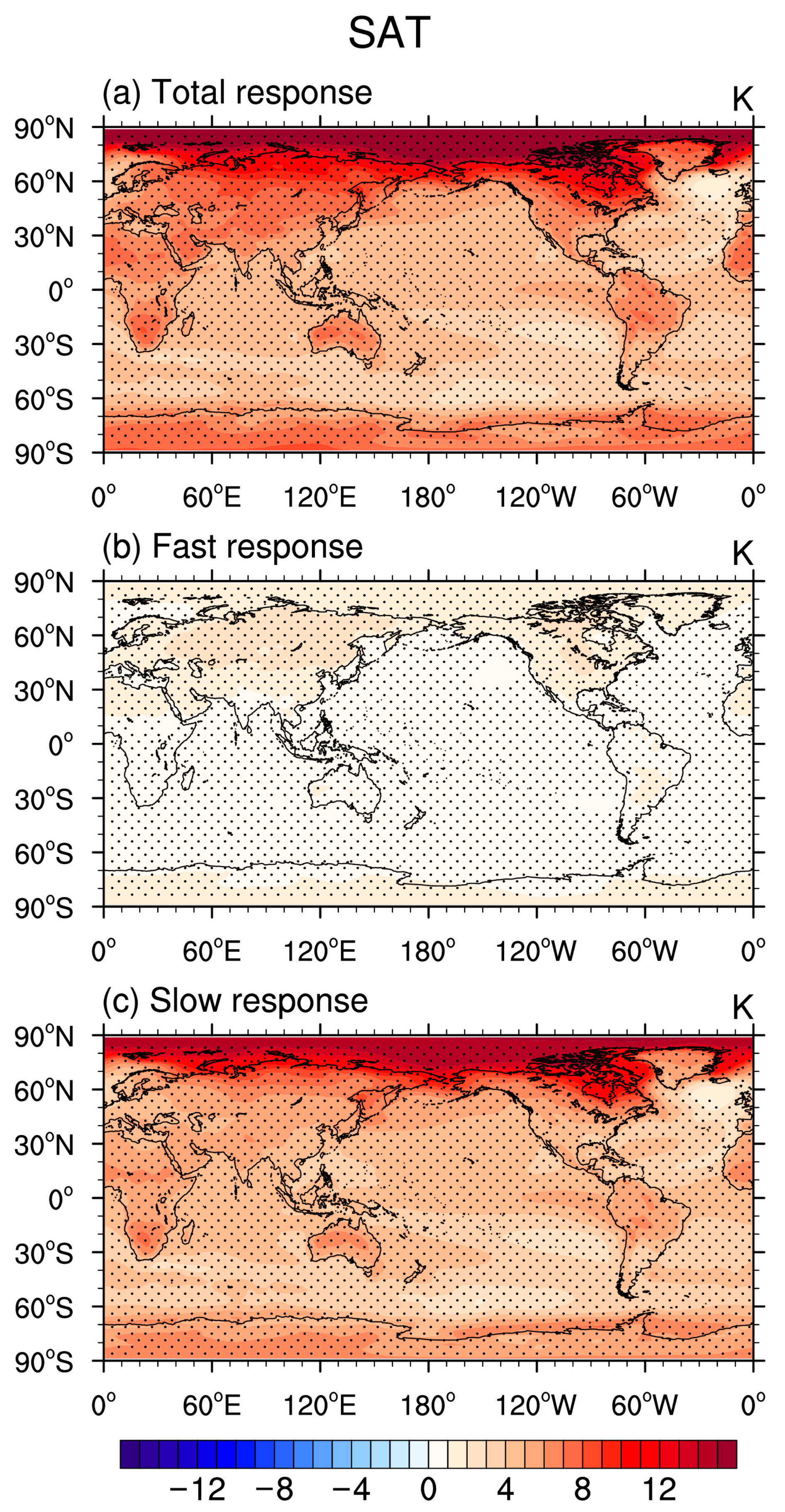

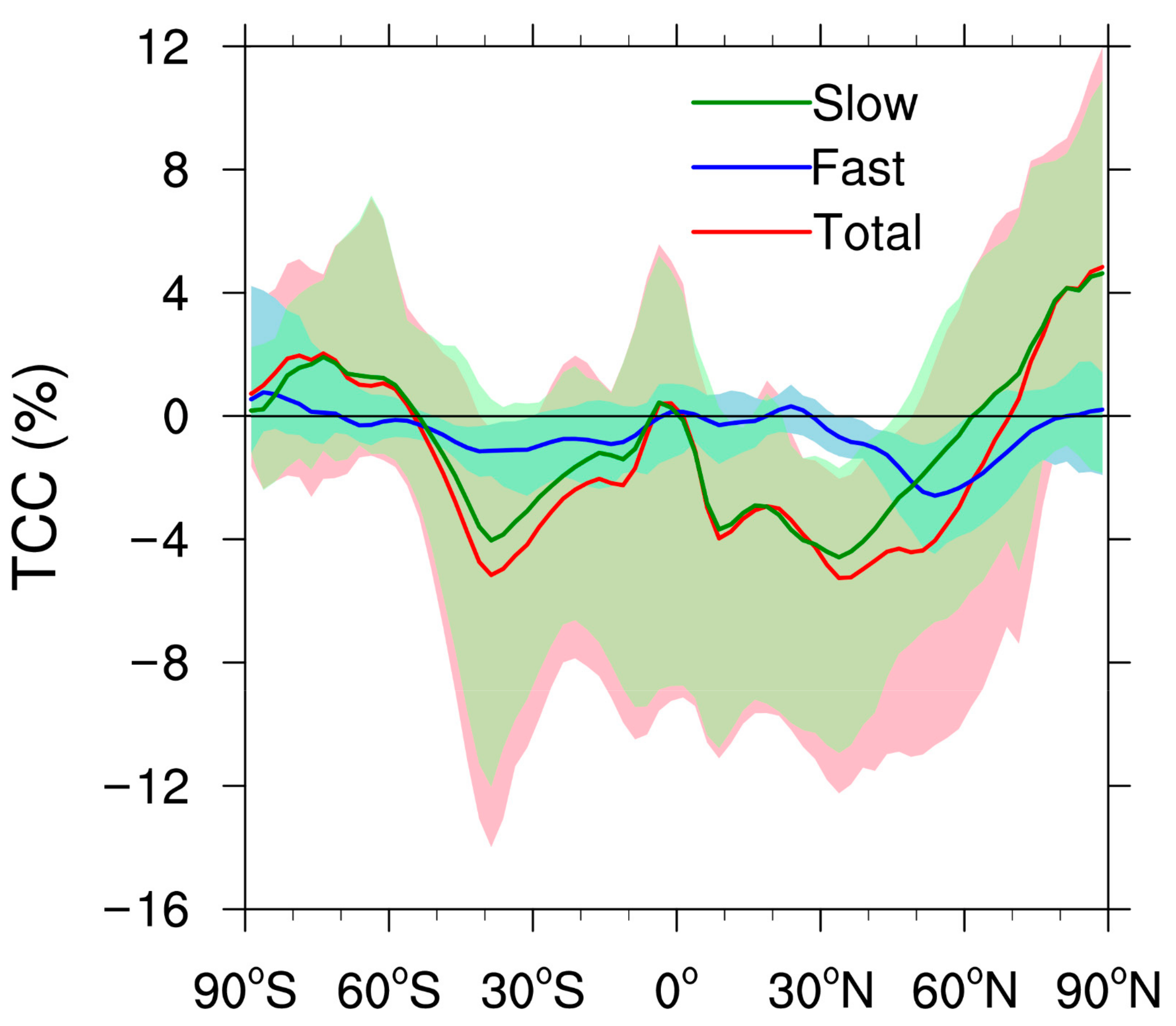
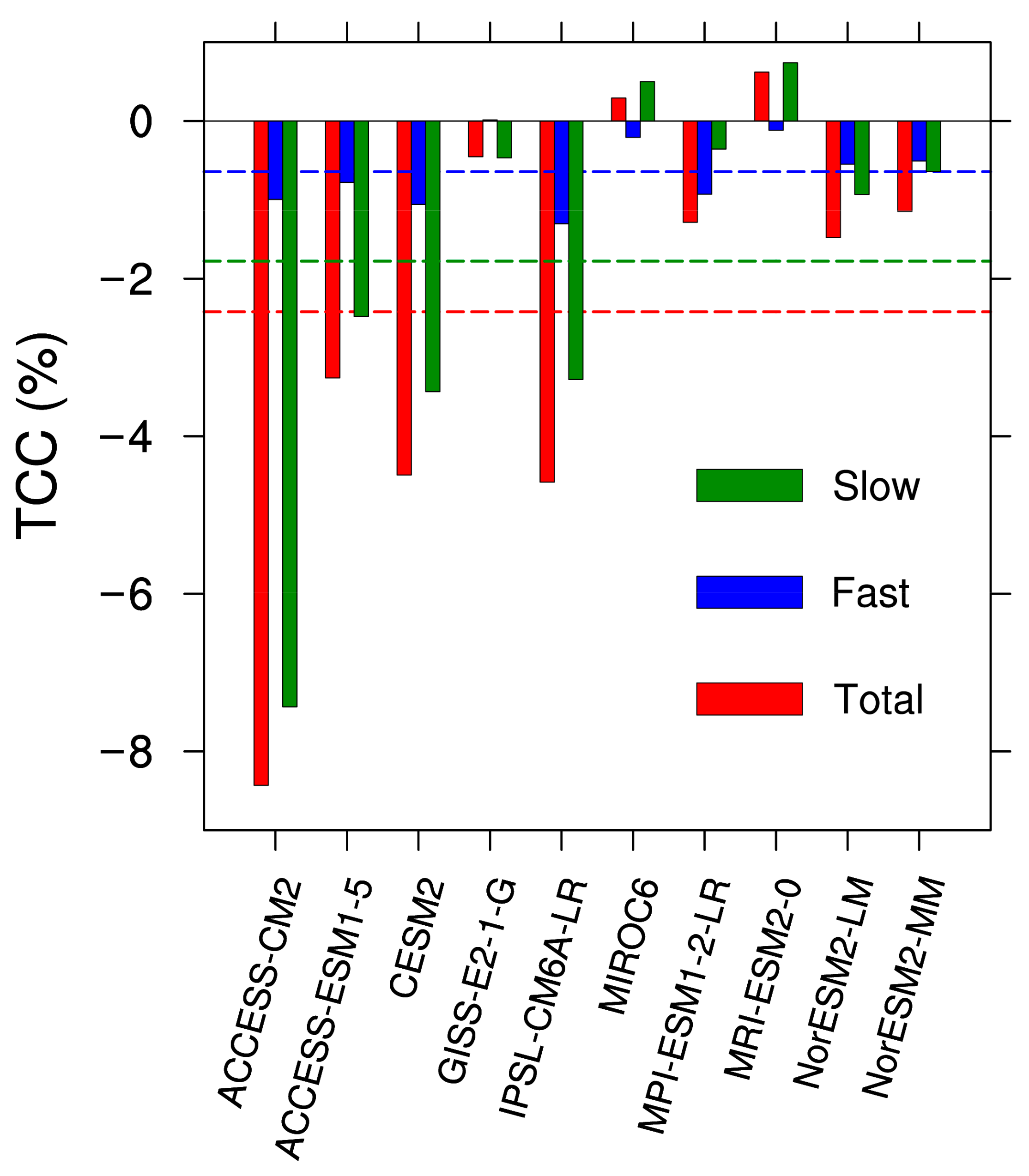
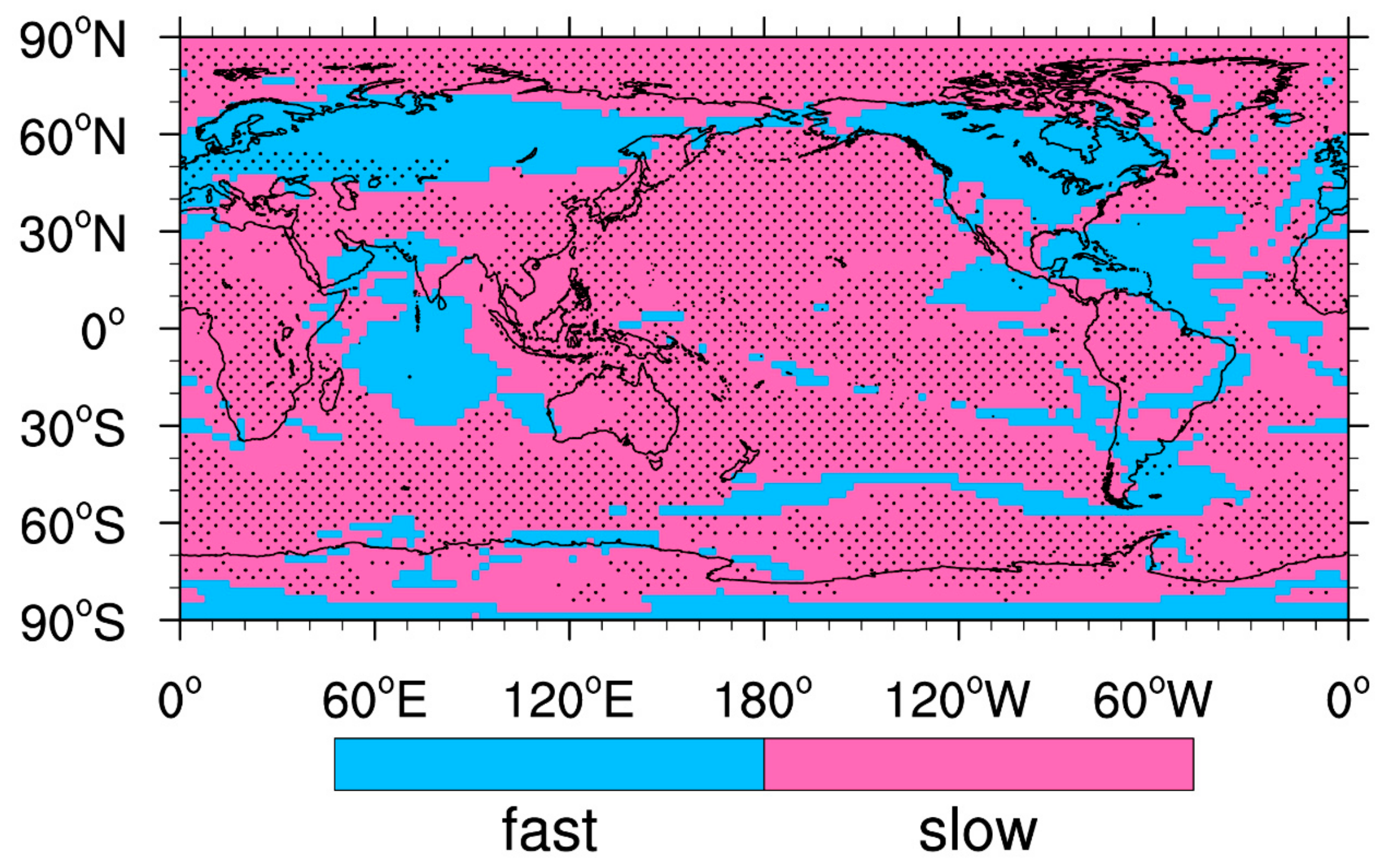

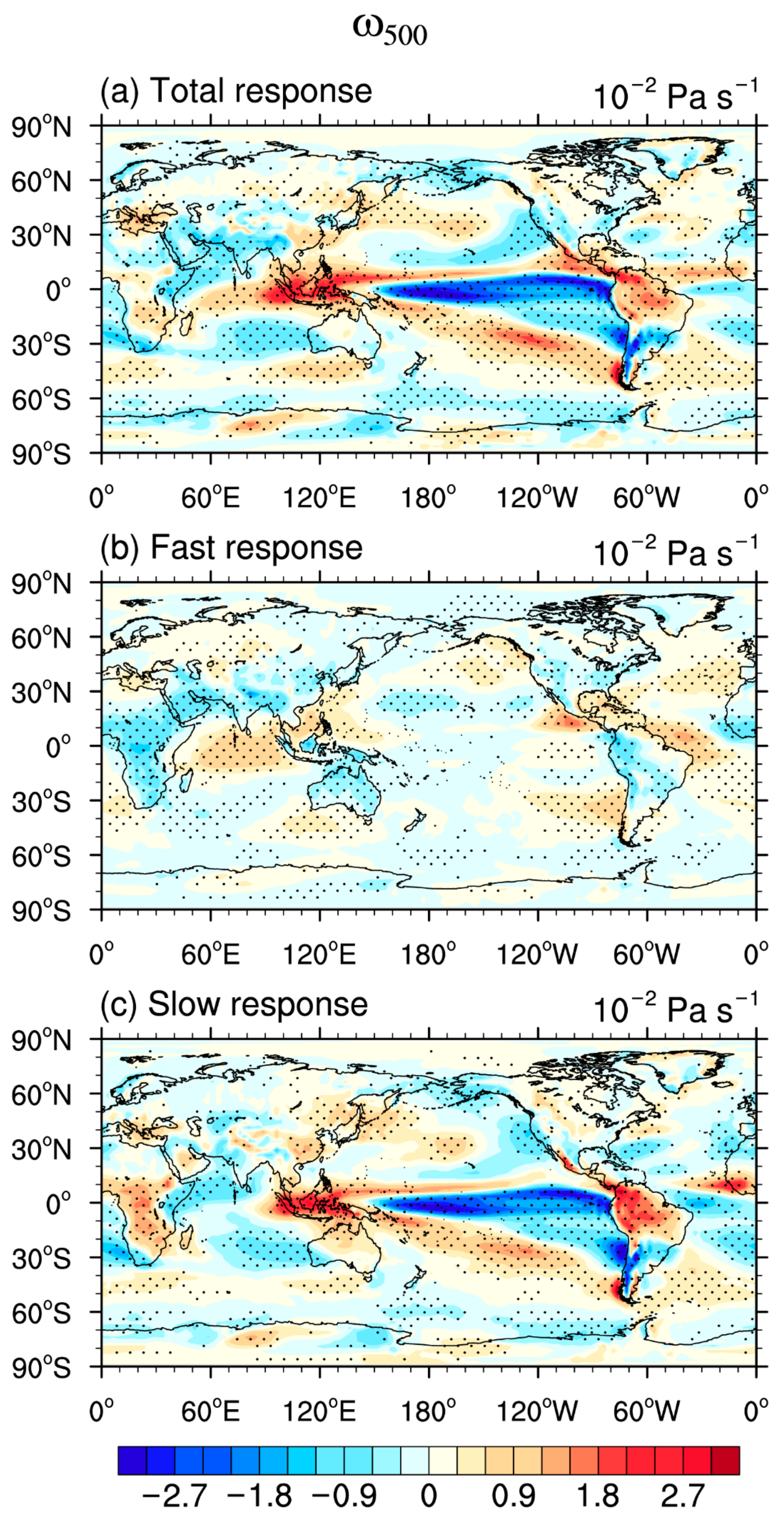

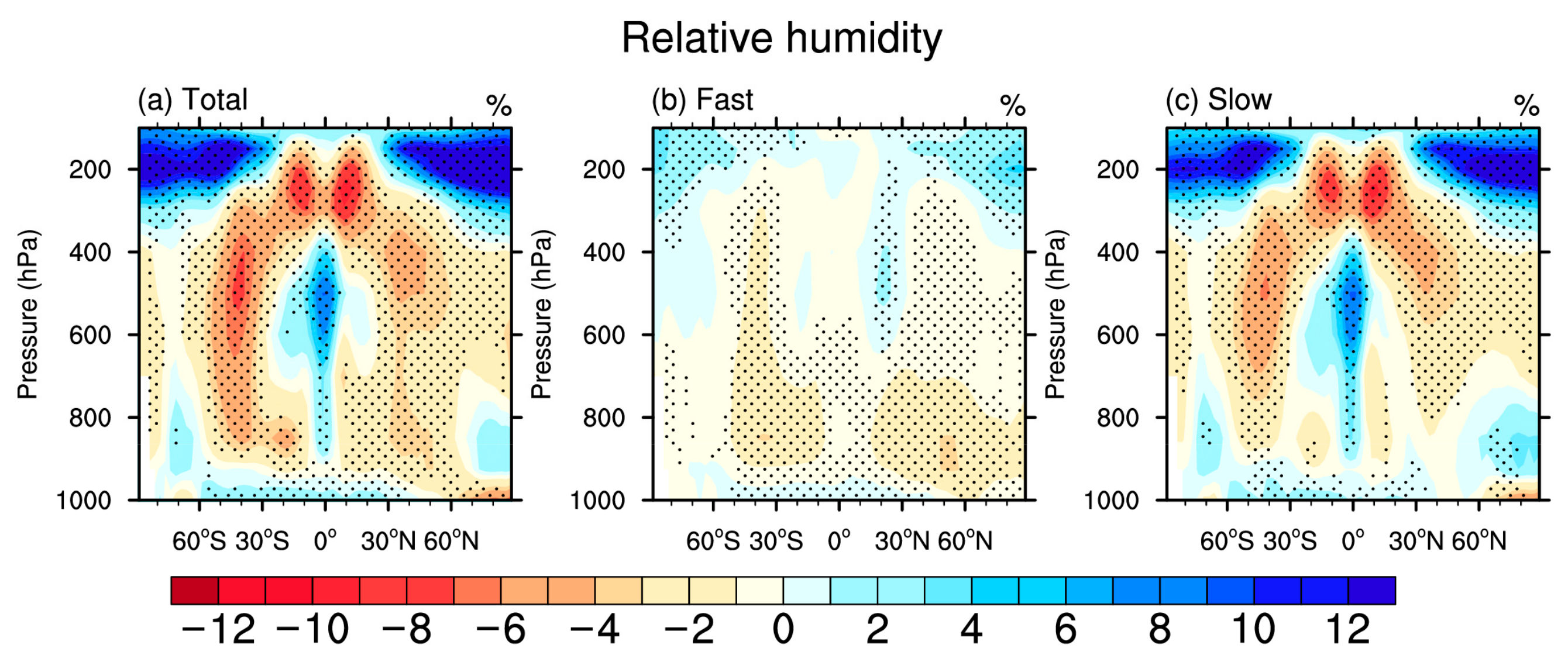
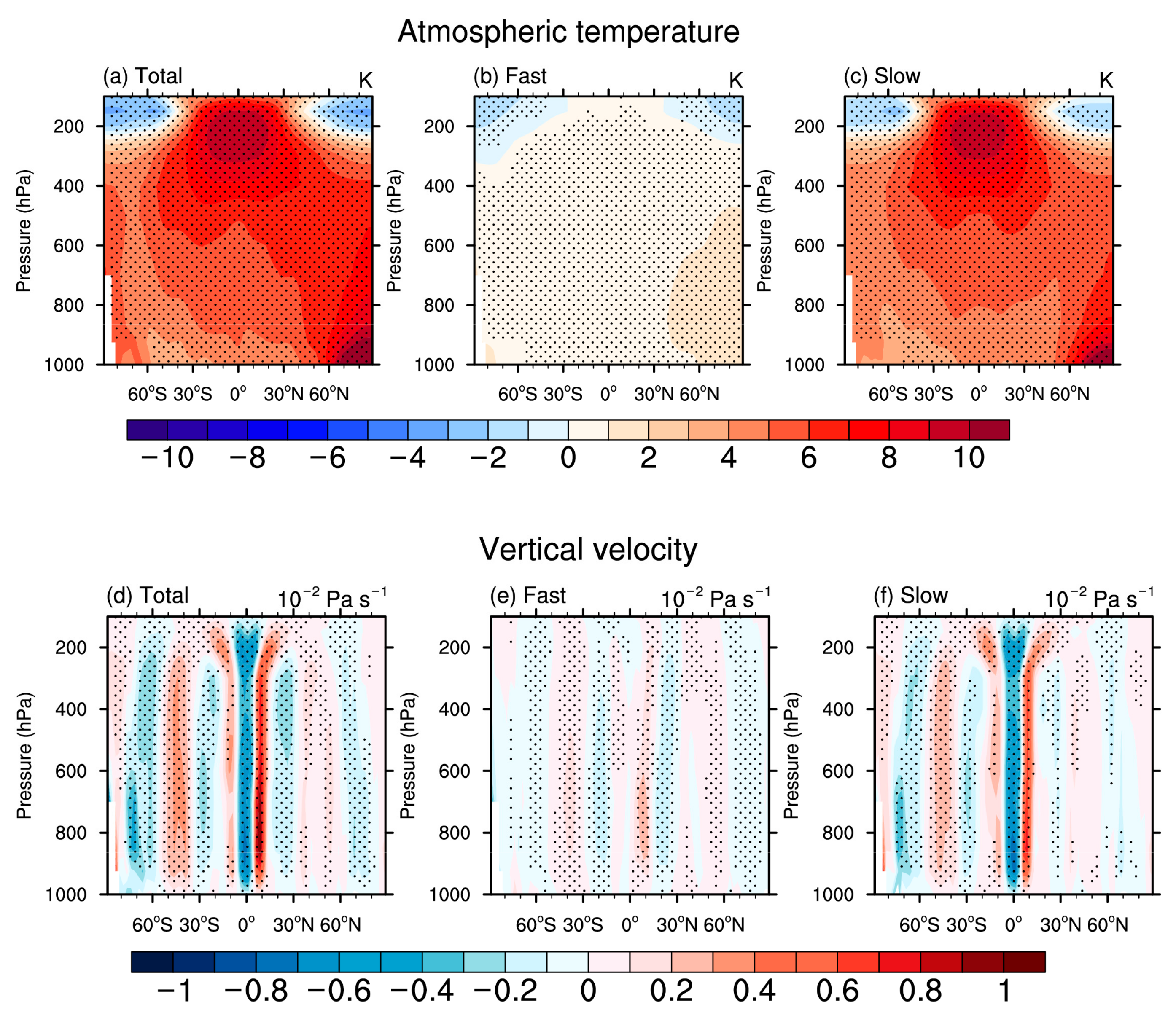
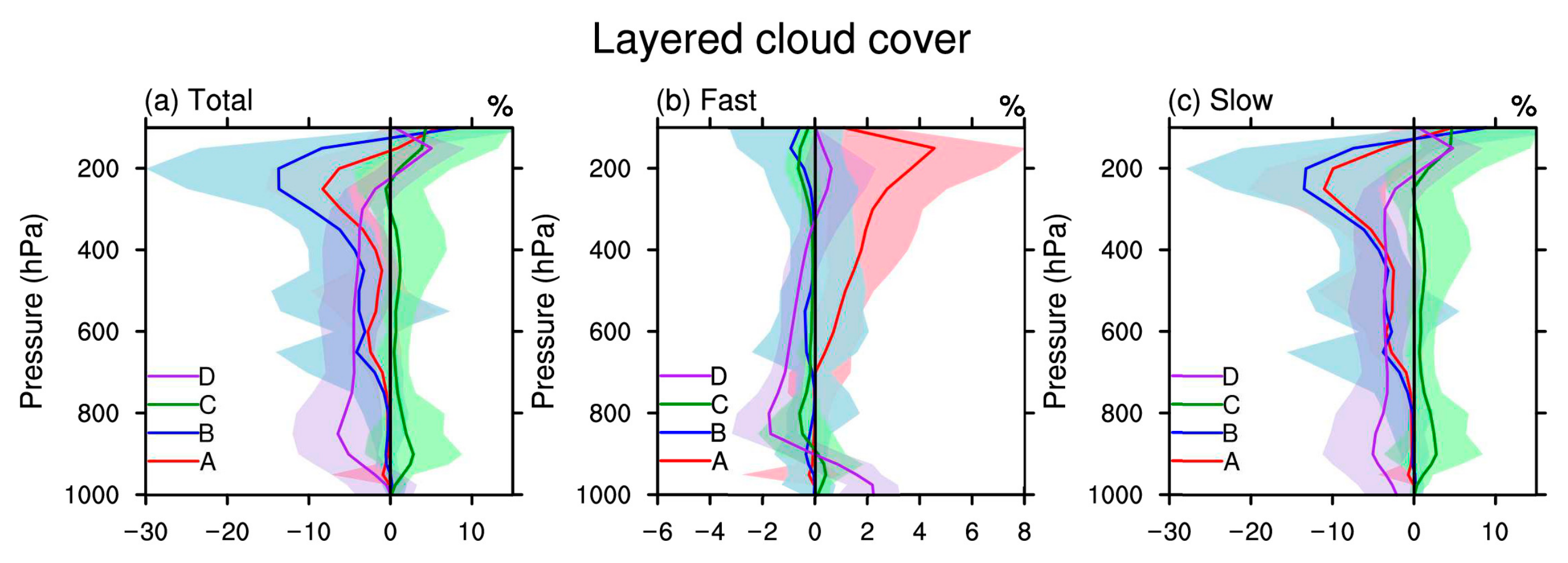


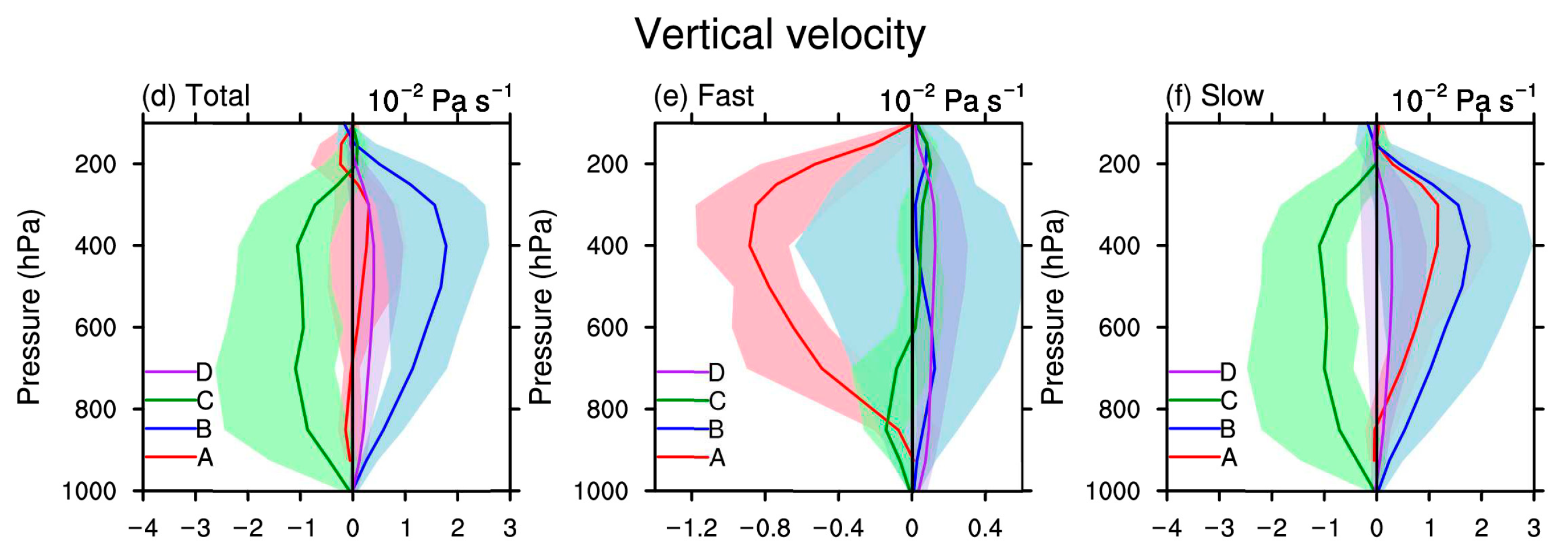
| Model Name | Institution | Nation | Resolution (Longitude × Latitude) |
|---|---|---|---|
| ACCESS-CM2 | CSIRO-ARCCSS | Australia | 1.875° × 1.25° |
| ACCESS-ESM1-5 | CSIRO | Australia | 1.875° × 1.25° |
| CESM2 | NCAR | USA | 1.25° × 0.9375° |
| GISS-E2-1-G | NASA-GISS | USA | 2.5° × 2° |
| IPSL-CM6A-LR | IPSL | France | 2.5° × 1.25° |
| MIROC6 | MIROC | Japan | 1.4° × 1.4° |
| MPI-ESM1-2-LR | MPI-M | Germany | 1.875° × 1.875° |
| MRI-ESM2-0 | MRI | Japan | 1.125° × 1.125° |
| NorESM2-LM | NCC | Norway | 2.5° ×1.875° |
| NorESM2-MM | NCC | Norway | 1.25° × 0.9375° |
| Global | A | B | C | D | |||||||||||
|---|---|---|---|---|---|---|---|---|---|---|---|---|---|---|---|
| Total | Fast | Slow | Total | Fast | Slow | Total | Fast | Slow | Total | Fast | Slow | Total | Fast | Slow | |
| TCC (%) | −2.42 | −0.64 | −1.78 | −5.12 | 3.01 | −8.13 | −6.76 | −0.82 | −5.94 | 9.95 | −1.14 | 11.09 | −5.95 | 0.44 | −6.39 |
Disclaimer/Publisher’s Note: The statements, opinions and data contained in all publications are solely those of the individual author(s) and contributor(s) and not of MDPI and/or the editor(s). MDPI and/or the editor(s) disclaim responsibility for any injury to people or property resulting from any ideas, methods, instructions or products referred to in the content. |
© 2023 by the authors. Licensee MDPI, Basel, Switzerland. This article is an open access article distributed under the terms and conditions of the Creative Commons Attribution (CC BY) license (https://creativecommons.org/licenses/by/4.0/).
Share and Cite
Zhou, X.; Zhang, H.; Wang, Q.; Xie, B. Decomposing Fast and Slow Responses of Global Cloud Cover to Quadrupled CO2 Forcing in CMIP6 Models. Atmosphere 2023, 14, 653. https://doi.org/10.3390/atmos14040653
Zhou X, Zhang H, Wang Q, Xie B. Decomposing Fast and Slow Responses of Global Cloud Cover to Quadrupled CO2 Forcing in CMIP6 Models. Atmosphere. 2023; 14(4):653. https://doi.org/10.3390/atmos14040653
Chicago/Turabian StyleZhou, Xixun, Hua Zhang, Qiuyan Wang, and Bing Xie. 2023. "Decomposing Fast and Slow Responses of Global Cloud Cover to Quadrupled CO2 Forcing in CMIP6 Models" Atmosphere 14, no. 4: 653. https://doi.org/10.3390/atmos14040653
APA StyleZhou, X., Zhang, H., Wang, Q., & Xie, B. (2023). Decomposing Fast and Slow Responses of Global Cloud Cover to Quadrupled CO2 Forcing in CMIP6 Models. Atmosphere, 14(4), 653. https://doi.org/10.3390/atmos14040653






